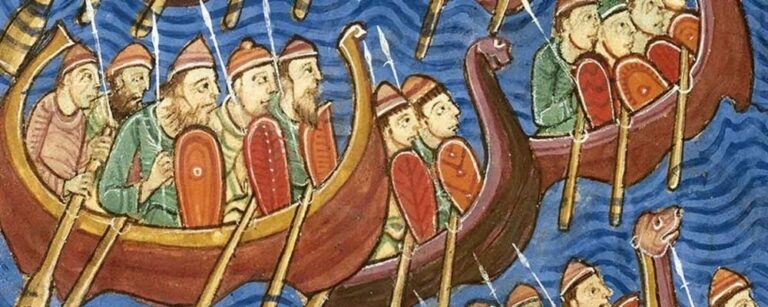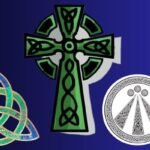We often talk about “the Vikings”, but the people that we think of today as Vikings were not in fact a homogenous group. They were northern Europeans from present-day Denmark, Norway, and Sweden whose culture thrived between the 8th and 11th centuries. They also shared a seafaring culture of exploration, trade, and also pillaging.
They spread from these home countries throughout the rest of Europe, settling in places like the British Isles, France, and Estonia, and also colonizing new areas, such as Iceland and Greenland.
But while these various peoples referred to as Vikings had a lot of social and cultural similarities, each culture also had its own unique elements.
So, in today’s article, let’s look at what it means not just to be a Viking, but a Danish Viking.

History of the Danes
The Danes were a Germanic tribe that moved into Denmark and southern areas of Sweden around the 6th century, expelling other Germanic people that were already settled in the area.
They were more politically and socially organized than the Vikings living further north, with a system of Kings, Jarls (noble landowners), Karls (free Men and women), and Thralls (slaves).
They would organize themselves into a single unified kingdom under King Gorm and his son Harald Bluetooth in the 10th century.
But even before that they were well organized enough to have an envoy stationed in the Court of Charlemagne in the 8th century. Around the same time, they also built a string of trading towns across their realm including Ribe, Aarhus, Viborg, Odense, Aalborg, and Hebedy, which quickly became the largest settlement in Scandinavia and remained so until it was destroyed in the 11th century.
They also built the fortification of Dannevirke as a line of defense at the southern border of their territory.

Danish Raiders
As well as being the most organized of the Vikings, they were also the most prolific raiders. From around the end of the 8th century, they carried out well-organized raids around Europe for around three centuries. They were particularly active in the British Isles, France, and areas of Germany.
The Danes terrorized their neighbours, who considered them the fiercest warriors in the region, and many would pay in exchange for them not attacking. But the Danes also established settlements in some areas. They most famously settled in the British Isles, where they had so much land that special areas of Danelaw were established to accommodate them.
By the early 11th century, the Danish ruler King Cnut the Great could boast that he ruled over a kingdom that included Denmark, England, Norway, Southern Sweden, and parts of Northern Germany.

Famous Warriors
Some of the most famous Vikings of all time were Danes. As well as Harald Bluetooth and King Cnut the Great, who we have already mentioned, the legendary Ragnar Lothbrok and his sons, including Bjorn Ironside and Ivar the Boneless, were also all Danes. Their exploits were made famous by the original Vikings series by the History Channel.

Danish Religion
The Danish Vikings spoke Old Norse and wrote with the runes, but they were not prolific writers. No extended texts survive from the Danish Viking world, only the occasional rune stone, and runes carved onto objects.
This reflects their religious beliefs and magical practices. Odin was the most important god in Denmark, as indicated by the large number of places named for the god. But while Thor also lent his name to individuals and many Danish Vikings seem to have worn Thor’s Hammer symbol, Mjolnir, for protection, Odin’s name was never used for individuals.
Scholars speculate that this was because Odin was considered a chaotic god, and so his name was not directly associated with individuals as it was too risky. Or perhaps he was considered too important to lend his name to mere mortals.
But there is strong evidence that the Danes believed that Odin and his Valkyries would choose the bravest of the fallen dead to dwell in Odin’s hall Valhalla. There the warriors would live among the gods until they are called on to fight again during the final battle of Ragnarok.

A series of burials of Danish warriors survive with extensive grave goods, giving them everything that they would need to fight alongside the gods at Ragnarok.
A number of burials of women who are assumed to have been Viking witches, Volva, also survive from Denmark. This, along with their use of runes, suggests that belief in magical practices was strong among the Danes.
While there is limited evidence for the worship of the Vanir gods Freyr and Freyja, these fertility deities seem to have been much more important among the other Vikings than among the Danes.
Harald Bluetooth officially changed the religion of Denmark to Christianity in the 10th century. But the two religions existed side by side for a long time before the community was fully converted.

Danish Art
Some of the most well-known Viking artistic styles also come out of the Danish community.
The Jelling style is named after a variety of artistic finds from the city dating from the 10th century. The style featured Scandinavian animal art with the bodies of animals extended and curled around themselves to make elaborate patterns.
The Mammen style is named for art found at that location in Jutland also dating to the 10th century. It includes an iron axe head with silver engraving from a Viking burial, decorated in this same animal art.

What Do You Think?
What do you think about the Danish Vikings? Are they the most ferocious warriors from the Viking world?







